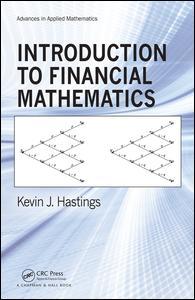Introduction to Financial Mathematics Advances in Applied Mathematics Series
Auteur : Hastings Kevin J.

Introduction to Financial Mathematics is ideal for an introductory undergraduate course. Unlike most textbooks aimed at more advanced courses, the textmotivates students through a discussion of personal finances and portfolio management. The author then goes on to covervaluation of financial derivatives in discrete time, using all of closed form, recursive, and simulation methods.
The text covers nearly all of the syllabus topics of the Financial Mathematics Actuarial examination, providing students with the foundation they require for future studies and throughout their careers. It begins by covering standard material on the mathematics of interest, including compound interest, present value, annuities, loans, several versions of the rate of return on an investment, and interest in continuous time.
The text explains how to value bonds at their issue dates, at coupon times, between coupon times, and in cases where the bonds are terminated early. Next, it supplies a rapid-fire overview of the main ideas and techniques of discrete probability, including sample spaces and probability measures, random variables and distributions, expectation, conditional probability, and independence.
The author introduces the basic terminology of stocks and stock trading. He also explains how to derive the rate of return on a portfolio and how to use the idea of risk aversion to model the investor tradeoff between risk and return. The text also discusses the estimation of parameters of asset models from real data.
The text closes with a detailed discussion of how to value financial derivatives using anti-arbitrage assumptions. The one-step and multi-step cases are covered, and exotic options such as barrier options are also introduced, to which simulation methods are applied.
Many of the examples in the book involve numerical solution of complicated non-linear equations; others ask students to produce algorithms which beg to be implemented as programs. For maximum flexibility, the author has produced the text without adhering to any particular computational platform.
A digital version of this text is also available in the form of Mathematica notebooks that contain additional content.
Theory of Interest. Bonds. Discrete Probability for Finance. Portfolio Theory. Valuation of Derivatives. Appendix: Answers to Selected Exercises. Bibliography. Index.
Kevin Hastings is Professor of Mathematics; Rothwell C. Stephens Distinguished Service Chair at Knox College. He holds a Ph.D. from Northwestern University. His interests include applications to real-world problems affected by random inputs or disturbances. He is the author or three other books for CRC Press:
Introduction to Probability with Mathematica, 2nd ed., Chapman & Hall/CRC Press, 2009.
Introduction to the Mathematics of Operations Research with Mathematica, 2nd edition, Taylor & Francis/Marcel Dekker, 2006.
Introduction to Probability with Mathematica. CRC Press/Chapman & Hall, November, 2000. Also issued electronically.
Date de parution : 10-2015
15.6x23.4 cm
Thèmes d’Introduction to Financial Mathematics :
Mots-clés :
Nominal Yearly Rate; Continuous Annuity; Personal Finance; Conditional Expectation; Capm Model; Risk Free Asset; Financial Mathematics; Risky Asset; Actuarial Mathematics; Amortization Table; Portfolio Optimization; Cumulative Distribution Function; Brownian Motion And Stochastic Calculus; Ordinary Annuity; Nominal Yearly Interest Rate; Sinking Fund; Strike Price; Risk Neutral Probability; Risk Free Rate; Annuity Due; Asian Call Option; Markov Process; Effective Yearly Rate; Call Option; European Call Option; Underlying Asset; Coupon Rate; Coupon Payments; Yield Rate; Barrier Option; Sample Space



